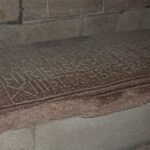The Spiritual Variant, together with the Traslatio, has a route of about 44 kilometers on foot and
28 km (15 nautical miles) done by sea, leaving from the port of Vilanova de Arousa to the port of Pontecesures, the last navigable stretch of the river Ulla, where we will disembark and travel the last 26 kilometers to our destination, Santiago de Compostela.
The route of this variant begins inPontevedra.
The variant goes from Pontevedra to Poio and from there the most significant thing is to be able to spend the night at the next point, the Monastery of Armenteira
A monastery that is more than 850 years old and full of history.
The monastery belongs to the municipality of Meis and is located in the heart of Salnés.
A group of nuns from the Cistercian order live, work, and are a great source of history there.
A place to relax and soak up all the history of the area and a very well preserved building, and truly, one of the jewels and attraction of this variant.
A real luxury to spend the night in this monastery and wake up in the silence of nature.
Walking through its gardens and talking with the nuns will be an experience that, together with our entire journey, will be recorded forever in our pilgrimage along the way.
Our last stretch before boarding will be approximately 23 kilometers, which will take us to the port of Vilanova de Arousa, Puerto Xacobeo.
On our boat route from Vilanoa de Arousa to the port of Pontecesures, we will navigate both the salt waters of the Ría de Arousa and the fresh waters of theUlla River.
On our tour we will find the trays of the best mussel in the world, the Ría de Arousa mussel, and the only seafood product with a designation of origin. We will also see countless people and boats working the Arousa Sea.
We will pass next to the Isla de Cortegada, an island belonging to the Illas Atlánticas National Park, and located in front of the town of Carril, famous for its clams and farm parks.
Even depending on the time of year, we can meet people who are dedicated to fishing for one of the most precious fish in the sweetest waters along the route, the lamprey.
A fish for which the Romans had a special predilection and for which a festival is held at the end of March in which it can be tasted.
On our ascent towards Pontecesures we will meet the cruceiros on both banks of the river.
These stone monuments, almost for the most part, were transferred from other areas of Galicia to here, donated by some municipalities and some individuals. There are a total of 17 and they mark both banks of the Ría de Arousa and the Ulla River a Via Crucis that marks the Translatio as the last stretch of the sea journey of the remains of the Apostle James, on its long journey from Jaffa (Jerusalem) to Santiago de Compostela.
We will also find the Torres de Oeste in the town of Catoira.
Towers that since the 12th century were defending the lands of the archdiocese of Santiago de Compostela from Viking attacks in the early and late Middle Ages. In this same town, every first Sunday of the month of August, the Viking Pilgrimage is celebrated. A festival declared ofNational Tourist Interestand in which a Viking invasion is recreated without lack of detail in which fun is more than guaranteed.
As you can see, it is a new route that combines nature, spirituality, good gastronomy and of course, a last section in which we will leave the province of Pontevedra in >boat to enter the waters of another province, A Coruña, where our final destination is, Santiago de Compostela.
The two photos of Armenteira are provided by Imaxina Novas Tecnoloxías SL.
















